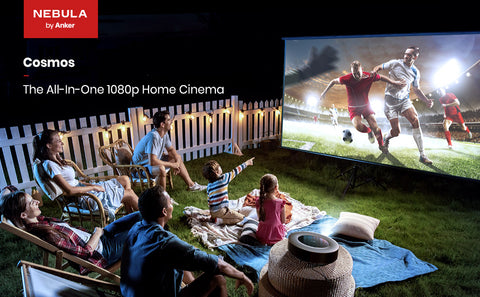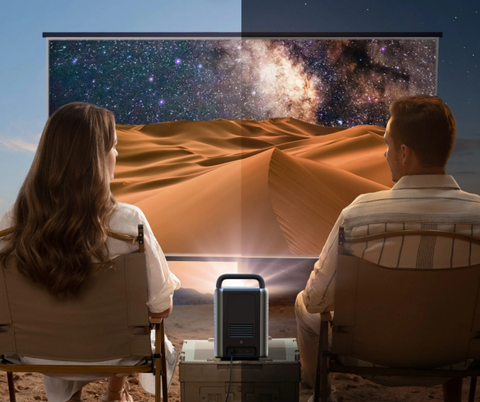
Screen Mirroring Projector - Elevate Your Visual Experience
Share
Screen mirroring to a projector, often known as "how to screen cast to a projector," is a technology that has become indispensable in today's digital age. This process allows you to display the content from your smartphone, tablet, or computer on a projector, making it essential for various scenarios.
Screen mirroring projector simplifies the sharing of content, making it ideal for business presentations, education, and home entertainment. It eliminates the need for everyone to crowd around a small screen and offers versatility by enabling seamless switching between different content types. In this guide, we'll explore how to achieve screen mirroring on projectors using both Android and iOS devices, unlocking the full potential of your devices and projectors.

How to screen mirror android devices to projector
Screen mirroring Android devices to a projector can be accomplished through various methods:
1. Wireless Screen Mirroring:
Technology Overview: In doing wireless screen mirroring android to projector, the action relies on technologies like Miracast or Google Cast to transmit the screen content from your Android device to the projector over a Wi-Fi connection.
Steps to Wireless Screen Mirroring:
- Compatibility Check: First, ensure that your Android device supports wireless screen mirroring. Most modern Android devices do, but it's always good to confirm.
- Projector Compatibility: Check whether your projector supports Miracast or has Google Cast built-in. This information can usually be found in the projector's user manual or specifications.
- Connect to Wi-Fi: Make sure both your Android device and the projector are connected to the same Wi-Fi network.
- Android Settings: On your Android device, go to the "Settings" app.
- Display Settings: Navigate to "Display" or "Screen" settings (the specific wording may vary depending on your device).
- Cast Screen: Look for an option like "Cast Screen" or "Screen Mirroring." Tap on it.
- Select Projector: In screen mirroring android, your Android device will scan for available devices to cast to. When the projector is detected, select it from the list.
- Mirror Screen: Once connected, your Android device's screen will be mirrored on the projector. You can now use your device as usual, and everything will be displayed on the larger screen.
2. Cable Connection:
Technology Overview: Cable connection involves physically connecting your Android device to the android projector using an HDMI cable and an appropriate adapter (e.g., USB-C to HDMI) if needed.
Steps for Cable Connection:
- Check Ports: Determine the type of ports available on your Android device (e.g., USB-C, micro USB, HDMI) and the projector (typically HDMI).
- Acquire Adapter: If your Android device and projector have different types of ports, obtain the necessary adapter to connect them.
- Connect the Cable: Plug one end of the HDMI cable into the projector's HDMI port and the other end into your Android device (via the adapter if needed).
- Select HDMI Input: On the projector, use the remote control or on-screen menu to select the HDMI input where your Android device is connected.
- Set Display Mode:On your Android device, go to "Settings" > "Display" to configure the display mode. You can choose to mirror the screen or extend it, depending on your preferences.
3. Third-Party Apps:
Technology Overview: Third-party apps like AllCast and AirScreen provide an alternative way to mirror your Android device's screen to a projector.
Steps for Using Third-Party Apps:
- Install the App:Go to the Google Play Store on your Android device and search for the screen mirroring app of your choice. Download and install the app.
- Open the App: Launch the third-party app on your Android device.
- Follow App Instructions: These apps typically have on-screen instructions to guide you through the setup process.
- Connect to the Projector: You'll usually need to select the projector or input device you want to connect to within the app.
- Mirror Your Screen: Once connected, the app will start mirroring your Android device's screen to the projector.
How to mirror android phone to projector? These three methods provide flexibility in how you can screen mirror your Android device to a projector and how to make screen mirroring work. Choose the one that best suits your device compatibility, available equipment, and user preferences.
How to screen mirror ios devices to projector
Screen mirroring iOS devices to a projector can be achieved through various methods. In this section, we'll explore three primary approaches: Using AirPlay, Using a Lightning to HDMI Adapter, and Using Third-Party Apps.

1. Using AirPlay:
Technology Overview: AirPlay is an Apple technology that allows wireless screen mirroring between iOS devices and AirPlay-compatible projectors, Apple TV, or smart TVs. It enables you to display your iPhone or iPad's screen on a larger display effortlessly.
Steps for Using AirPlay Connection:
- Ensure Your Devices Are on the Same Wi-Fi Network: Connect your iOS device and the AirPlay-compatible projector to the same Wi-Fi network.
- Access Control Center: Swipe down or swipe up (depending on your iOS version) from the upper-right corner of your screen to open the Control Center.
- Enable Screen Mirroring: In the Control Center, tap "Screen Mirroring." This will display a list of available AirPlay devices, including your projector.
- Select Your Projector: Tap on the name of your projector from the list. A passcode may appear on the projector screen; enter it on your iOS device if prompted.
- Start Mirroring: Your iOS device's screen will now be mirrored on the projector. You can navigate through apps, play videos, or present content as needed.
2. Using a Lightning to HDMI Adapter:
Technology Overview: A Lightning to HDMI adapter is a hardware solution that allows you to connect your iOS device directly to the projector via an HDMI cable. This method offers a wired connection, ensuring a stable and high-quality screen mirroring experience, whether you're using a MacBook or an iPhone projector setup.
Steps for Cable Connection:
- Get the Right Adapter: Purchase a Lightning to HDMI adapter that is compatible with your iOS device. Some adapters also include an additional Lightning port to charge your device while mirroring.
- Connect the Adapter: Plug the Lightning end of the adapter into your iOS device and the HDMI end into the projector.
- Select HDMI Input on the Projector: Use the projector's remote or menu to select the HDMI input where your iOS device is connected.
- Start Mirroring: Your iOS device's screen should appear on the projector. You can now use your device as usual, and the content will be mirrored in real-time.
3. Using Third-Party Apps:
Technology Overview: Some third-party apps like AirServer and Reflector provide screen mirroring functionality for iOS devices. These apps typically require both your iOS device and the projector to be on the same Wi-Fi network.
Steps for Using Third-Party Apps:
- Download a Screen Mirroring App: Search the App Store for screen mirroring apps compatible with your projector and iOS device. Install the app on your iOS device.
- Follow App Instructions: Open the app and follow the on-screen instructions to connect your iOS device to the projector.
- Start Mirroring: Once the connection is established, start screen mirroring through the app. Your iOS device's screen will appear on the projector.
These methods offer flexibility in mirroring your iOS device to a projector, catering to various preferences and situations, whether you're looking for screen mirroring iPhone to projector wirelessly or using other setups.
Guide Tutorial: Watch the video to learn how to screen mirror and cast content from your iPhone and Android phone.
Conclusion
screen mirroring projector bridges the gap between the small screens of our mobile devices and the larger canvases of projectors and TVs. It transforms the way we interact with our digital content, fostering enhanced engagement, communication, and creativity. The method chosen for screen mirroring may vary, but the overarching goal remains the same: to make content sharing more accessible and engaging.
Frequently Asked Questions about “screen mirroring projector”
Why is my projector not displaying my laptop?
Check the video ports on both the laptop and projector for any damage or bent pins. Inspect the video cable for visible damage, like frays or cuts. If no damage is found, try reconnecting the cable securely. If the issue persists, test with a different cable to rule out a faulty connection.
how to screen mirror netflix on projector?
How to screen cast to projector if I want to use Netflix? follow these steps:
- Ensure your projector supports screen mirroring and is connected to your Wi-Fi network.
- On your source device (e.g., smartphone, tablet, or computer), open the settings and enable screen mirroring.
- Select your projector from the list of available devices for screen mirroring.
- Once connected, open the Netflix app on your source device.
- Start playing the content you want to watch, and it will be mirrored on the projector.
This allows you to enjoy Netflix content on a larger screen through your projector.
What is the best projector for android phone?
The best projector for an Android phone depends on your specific needs, such as portability, resolution, and budget. Some popular options for smart projector with screen mirroring include the Anker soundcore Nebula Capsule, Epson Home Cinema series, and BenQ projectors. Consider factors like brightness, connectivity options, and image quality when choosing the best projector for your Android phone.
Does screen mirroring need wifi?
Yes, screen mirroring typically requires a Wi-Fi network or an equivalent wireless connection. It involves streaming or transmitting the content from one device to another in real-time. Wi-Fi enables this wireless data transfer, making it a key component of most screen mirroring methods.
However, there are some exceptions, such as wired connections using cables like HDMI or USB. In these cases, Wi-Fi is not needed, but wireless connections are more common for screen mirroring.